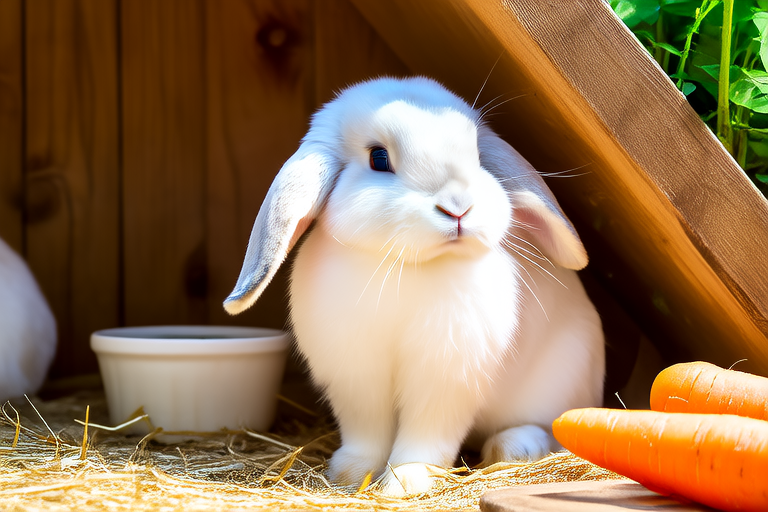Top Tips for Caring for Your Lop Rabbit at Home
Welcome to the wonderful world of lop rabbits! These charming, floppy-eared companions bring joy to many homes with their gentle nature and playful demeanor. Proper care ensures that your lop rabbit remains healthy, happy, and well-adjusted. This guide will cover essential aspects of lop rabbit care, including diet, housing, grooming, exercise, healthcare, and behavior management. Whether you’re a new or experienced owner, these tips will help you provide the best possible life for your furry friend.
Diet: Fueling Your Lop Rabbit’s Health
A balanced diet is crucial for maintaining your lop rabbit’s overall health. The primary components of a lop rabbit’s diet should be hay, fresh vegetables, and a limited amount of pellets. Timothy hay, which is rich in fiber, should make up the bulk of their daily intake. Fresh water should always be available, as dehydration can lead to serious health issues.
Variety is key when it comes to vegetables. Dark leafy greens like kale, spinach, and romaine lettuce are excellent choices. However, avoid feeding them iceberg lettuce as it has little nutritional value. Introduce new foods gradually to monitor for any adverse reactions. A small handful of high-quality rabbit pellets provides necessary vitamins and minerals. Overfeeding pellets can lead to obesity, so moderation is important.
Treats should be given sparingly. While lop rabbits enjoy fruits and root vegetables as treats, they should only constitute about 10% of their total food intake. Always remove uneaten food after an hour to prevent spoilage.
Housing: Creating a Comfortable Living Space
Your lop rabbit needs a safe, comfortable space to call home. A spacious cage or hutch is ideal, with dimensions no smaller than 4 feet by 2 feet by 2 feet. Ensure the enclosure has adequate ventilation and is placed away from direct sunlight and drafts. Wire-bottom cages are not recommended as they can cause foot injuries. Instead, opt for solid flooring covered with absorbent bedding such as straw or shredded paper.
Provide a cozy sleeping area with a soft blanket or towel. Rabbits love to burrow, so consider adding tunnels or cardboard boxes for additional comfort. Regular cleaning is essential to maintain hygiene. Remove soiled bedding daily and perform thorough cleaning once a week.
Grooming: Maintaining Your Lop Rabbit’s Appearance and Health
Lop rabbits require regular grooming to keep their coats clean and free from mats. Brush your rabbit at least twice a week, especially during shedding seasons. Use a slicker brush for short-haired breeds and a bristle brush for long-haired ones. Gently brush in the direction of hair growth to avoid discomfort.
Bathing should be kept to a minimum, as frequent bathing can strip natural oils from their skin. If necessary, use a gentle pet shampoo and ensure thorough rinsing to avoid irritation. Trim nails every few weeks to prevent overgrowth and discomfort. Consult your veterinarian if you’re unsure how to proceed.
Exercise: Keeping Your Lop Rabbit Active and Healthy
Rabbits are naturally active animals that need plenty of opportunities to move around. Allow your lop rabbit supervised playtime outside of its enclosure daily. A secure, rabbit-proofed room or outdoor pen allows for exploration and exercise. Provide toys such as chew sticks, balls, and tunnels to stimulate mental and physical activity.
Supervised outdoor time is beneficial but requires careful supervision. Ensure the area is enclosed to prevent escape and protect against predators. Avoid areas with toxic plants and potential hazards. Regular exercise helps maintain a healthy weight and reduces the risk of obesity-related diseases.
Healthcare: Ensuring Your Lop Rabbit’s Well-being
Regular veterinary check-ups are vital for early detection of health issues. Discuss with your vet the appropriate vaccination schedule and preventive measures for common diseases. Parasite control, including fleas and worms, should be part of routine care. Flea treatments designed specifically for rabbits are safest.
Monitor your lop rabbit for signs of illness, such as lethargy, loss of appetite, runny nose, or diarrhea. Early intervention is critical in treating and managing health problems. Maintain a clean living environment to minimize the risk of infections. Clean litter trays daily and wash bedding regularly.
Behavioral Tips: Understanding and Managing Your Lop Rabbit’s Behavior
Lop rabbits are social animals that thrive on interaction. Spend quality time with your rabbit through petting, playing, and training. Positive reinforcement techniques, such as clicker training, can teach basic commands and encourage good behavior. Patience is key, as rabbits may take time to learn and respond.
Some common behavioral issues include chewing furniture and digging. Redirect these behaviors by providing appropriate chew toys and digging boxes. Consistency in training and environmental enrichment can help manage undesirable habits. Establish a routine for feeding, exercise, and playtime to create a predictable and comforting environment for your lop rabbit.
Common Challenges and Solutions
One of the most common challenges for lop rabbit owners is preventing obesity. Limit high-calorie treats and ensure ample exercise opportunities. Another challenge is dealing with destructive behavior. Providing adequate stimulation and outlets for natural behaviors can reduce the likelihood of damage.
Socialization is another important aspect of lop rabbit care. Introducing your rabbit to other pets and people can help them become more comfortable in various settings. Gradual introductions and positive reinforcement can facilitate successful socialization.
Understanding and addressing your lop rabbit’s unique needs will contribute to their happiness and longevity. By following these top tips, you’ll be well-equipped to provide the best possible care for your lop rabbit at home.
